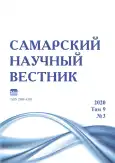Анализ структуры планктонных водорослей рек Волга и Кама (Республика Татарстан)
- Авторы: Халиуллина Л.Ю.1
-
Учреждения:
- Казанский (Приволжский) федеральный университет
- Выпуск: Том 9, № 3 (2020)
- Страницы: 158-165
- Раздел: Общая биология
- URL: https://journal-vniispk.ru/2309-4370/article/view/50632
- DOI: https://doi.org/10.17816/snv202093126
- ID: 50632
Цитировать
Полный текст
Аннотация
В статье представлены результаты сравнительного анализа структуры планктонных водорослей рек Волга и Кама, при слиянии образующих Куйбышевское водохранилище, а также проведена оценка трофического состояния исследуемых участков рек в 2012 г. Гидрохимический режим Куйбышевского водохранилища неоднороден и определяется химическим составом волжских и камских вод, которые различаются по соотношению ионов и минерализации. В ионном составе камских вод часто преобладают сульфаты, а минерализация в зависимости от сезона и водности года колеблется от 168 до 674 мг/л. Волжские воды являются гидрокарбонатными кальциевыми и имеют меньшую минерализацию (120–130 мг/л). Разнокачественность поступающей воды, величина стока, степень сработки объема, внутриводоемные процессы и подтоки грунтовых вод в первую очередь сказываются на условиях существования планктонных водорослей. В фитопланктоне рек Волга и Кама (на участках перед их слиянием в Куйбышевском водохранилище) в вегетационный период 2012 г. выявлено 123 таксонов водорослей. Воды р. Волга имеют более высокое видовое разнообразие (107 видов). Фитопланктон р. Кама менее разнообразен (76 видов). В сезонной динамике планктонных водорослей исследованных участков рек было выявлено два пика численности и биомассы – во второй декаде июля и в течение августа. Если для вод исследуемых участков р. Волга характерен комплекс фитопланктона из синезеленых, диатомовых и зеленых и водорослей, то в р. Кама преобладает диатомовый фитопланктон. Летом и осенью «цветение» воды в обеих реках обусловлено массовым развитием синезеленых водорослей родов Microcystis, Aphanizomenon, Anabaena, Oscillatoria. Воды р. Волга и р. Кама в 2012 г. в период исследований соответствовали мезасапробному типу и умеренно-загрязненной зоне, причем воды р. Кама имели более высокие показатели сапробности. Трофический статус рассматриваемых рек в районе исследований большей частью относился к эвтрофному, а в периоды максимального размножения синезеленых водорослей – к гиперэвтрофному типу.
Ключевые слова
Полный текст
Открыть статью на сайте журналаОб авторах
Лилия Юнусовна Халиуллина
Казанский (Приволжский) федеральный университет
Автор, ответственный за переписку.
Email: liliya-kh@yandex.ru
кандидат биологических наук, доцент кафедры ботаники и физиологии растений
Россия, КазаньСписок литературы
- Куйбышевское водохранилище (Научно-информационный справочник). Тольятти: ИЭВБ РАН, 2008. 123 с.
- Экология фитопланктона Куйбышевского водохранилища. Л.: Наука, 1989. 304 с.
- Халиуллина Л.Ю., Яковлев В.А. Фитопланктон мелководий в верховьях Куйбышевского водохранилища. Казань: Изд-во АН РТ, 2015. 171 с.
- Khaliullina L.Yu., Khaliullin I.I., Yakovlev V.A. Seasonal and year-to-year dynamics of phytoplankton in connection with the level regime of the Kuibyshev Reservoir // Water Resources. 2009. Vol. 36, № 4. С. 459–465.
- Водоросли. Справочник. Киев: Наук. думка, 1989. 608 с.
- Садчиков А.П. Методы изучения пресноводного фитопланктона. М.: Университет и школа, 2003. 200 с.
- AlgaBase is a database of information on algae that includes terrestrial, marine and freshwater organisms [Internet] // https://www.algaebase.org.
- Cantonati M. Freshwater bentic diatoms of Central Europe: over 800 common species used in ecological assessment. Berlin: Spektrum Akademischer Verlag, 2017. 942 s.
- Krammer K. Bacillariophyceae. 3. Teil: Centrales, Fragilariaceae, Eunotiaceae. Susswasserflora von Mitteleuropa. Berlin: Spektrum Akademischer Verlag, 1991. 576 s.
- Krammer K. Bacillariophyceae. 4. Teil: Achnanthaceae, Kritische Erganzungen zu Navicula (Lineolatae) und Gomphonema. Susswasserflora von Mitteleuropa. Berlin: Spektrum Akademischer Verlag, 1991. 437 s.
- Pröschold T., Leliaert F. Systematics of the green algae: conflict of classic and modern approaches // Unravelling the algae. The past, present, and future of algal systematics. The Systematics Association Special. 2007. Vol. 75. P. 123–153.
- Андроникова И.Н. Теоретические вопросы классификации озер. СПб.: Наука, 1993. С. 51–72.
- Sladecek V. System of water quality from the biological point of view // Archiv für Hydrobiologie Beihefte: Ergebnisse der Limnologie. 1973. Bd. 7. 189 p.
- Булыгина О.Н., Коршунова Н.Н., Разуваев В.Н. Погода на территории Российской Федерации в 2012 году [Электронный ресурс] // Федеральная служба по гидрометеорологии и мониторингу окружающей среды. – http://meteo.ru/93-klimaticheskie-usloviya/190-2012.
Дополнительные файлы












